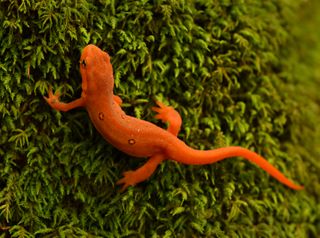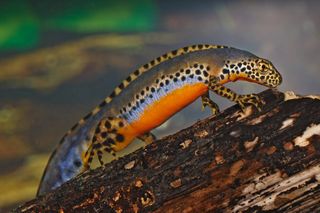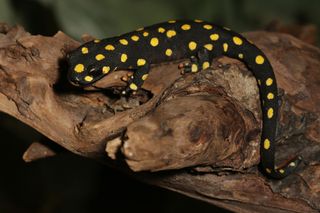Facts About Newts

Newts are small semi-aquatic amphibians that look like a cross between a frog and a lizard. Newts possess several interesting characteristics. For example, though they may look cute and harmless, they can be dangerous; toxins secreted through the skin as a defense mechanism could kill a person. Newts also can regrow lost limbs and organs. That ability makes them important subjects in medical studies on regeneration. Also, some newts have flown on space missions.
Newts vs. salamanders
Newts are members of the Salamandridae family, and there are over 60 species. All newts are salamanders, but not all salamanders are newts. The differences between newts and salamanders are few, according to Caudata Culture, a website for newt and salamander enthusiasts. Generally, with some exceptions, newts spend more of their adult lives in the water than salamanders. Also, there are more distinctive difference between the sexes in newts.
The main distinction between salamanders and newts is how they are classified. Newts belong to the genera Cynops, Echinotriton, Euproctus, Neurergus, Notophthalmus, Pachytriton, Paramesotriton, Pleurodeles, Taricha, Triturus or Tylototriton. "True salamanders" belong to Chioglossa, Mertensiella, and Salamandra, according to the Animal Diversity Web (ADW).
Size
Newts have lizard-shaped bodies with four legs and long tails. Most have smooth and moist skin, though some species, such as rough-skinned newts have, as one might expect, rough, grainy skin. Most species have well-developed lungs, while some retain gills and are completely aquatic.
With so many species, newts come in many different sizes. They are typically smaller than 8 inches (20 centimeters), according to Encyclopedia Britannica. For example, the warty newt grows to 7 inches (18 cm) and weighs 0.22 to 0.37 ounces (6.3 to 10.6 grams).

Habitat
Newts can be found all over the Northern Hemisphere in North America, Europe, Asia and north Africa. Some live on land while others live almost exclusively in water. For example, the alligator newt lives on the southern islands of Japan in swamps, forests, grasslands and croplands. The eastern red-spotted newt is found in eastern North America in ponds, lakes and marshes.
Habits
Many newts are active during the day while others are active during the night. All of them spend most of their time hunting for food or lounging in a cool area in the shade.
Their mating ritual is particularly interesting. When mating season comes, the male secretes a strong pheromone to attract a female. Then, it does a little dance by swinging its tail in the air. The pheromone works so well that when a male isn't around, females will try to mate with each other, according to a 2013 study by the Free University of Brussels. [Newt Pheromones Put Females into Mating Frenzy]
Eye of newt
Newts can regenerate fully functional limbs, organs and tissues, including heart muscle, components of its nervous system and the lens of its eye, according to an article in the journal Nature. Researcher hope the ability is based on a common genetic trait and is found, even in latent form, in all animals. Studies indicate, however, it may not be that simple because of the enormous size of the newt genome, which is 10 times larger than the human genome.

Toxic touch
Many newts rely on their skin color — green, black or brown — to camouflage them and escape the notice of predators. Others are marked with bright warning colors to indicate they are toxic and would not make a good meal, according to Caudata Culture.
These newts secrete a mucus that is quite toxic. A 1966 study published in the journal Toxicon found that at least 10 species had substances called tarichatoxin and tetrodotoxin. Tetrodotoxin, or TTX, is the most poisonous nonprotein substance known to scientists and is similar to that found in pufferfish, according to Caudata Culture. It is a powerful neurotoxin that block signals from the nervous system to the muscles, so for example, it blocks the signals from your brain that tell your heart to beat.
The study found that the skin of a rough-skinned newt is poisonous enough to potentially kill 25,000 mice. The study also cited a case that involved a man in Oregon who swallowed a newt on a dare (he had been drinking heavily). After a few minutes, his lips began to tingle. Over the next two hours he began to feel numb and weak and then experienced cardiopulmonary arrest. Later that day, he died, despite hospital treatment.
In another study, published in 1974 in the journal Copeia, newt toxin entered a puncture wound on a scientist's index finger, and he suffered 30 minutes of numbness up the arm into the shoulder, and some accompanying nausea and light-headedness.
Some newts add insult to injury. Besides secreting the toxin, the Spanish ribbed newt and alligator newt push their ribs through their skin to pierce their victims, making sure the poison enters the attacker's body.
Diet
Newts are carnivores. They eat slugs, worms, small invertebrates, amphibian eggs and insects on land. Tadpoles, shrimp, aquatic insects, insect larvae and mollusks are on the menu in the water. Baby newts, called larva, can feed themselves small shrimp and insect larvae they find while swimming around.

Offspring
Most newts lay eggs, and one female can lay hundreds of eggs. For example, the warty newt can lay 200 to 300 eggs, according to National Geographic. However, they lay them one at a time and attach them to aquatic plants, according to A-Z Animals. Frogs, on the other hand, lay their eggs in clumps that float close to the surface of the water. A few newt species lay their eggs on land.
Newt babies, called tadpoles, resemble baby fish with feathered external gills. Much like frogs, newts evolve into their adult form. Some go from egg to larva to adult, while others evolve from egg to larva to juvenile to adult.
Classification/taxonomy
Here is the taxonomic information for newts, according to the Integrated Taxonomic Information System (ITIS):
Kingdom: Animalia Subkingdom: Bilateria Infrakingdom: Deuterostomia Phylum: Chordata Subphylum: Vertebrata Infraphylum: Gnathostomata Superclass: Tetrapoda Class: Amphibia Order: Caudata Family: Salamandridae Genera:
- Calotriton (European brook newts) — 2 species
- Cynops (firebelly newts) — 7 species
- Echinotriton (mountain newts) — 2 species
- Ichthyosaura (alpine newts) — 1 species
- Lissotriton (smooth newts) — 10 species
- Neurergus (Kurdistan newts) — 4 species
- Notophthalmus (Eastern Newts, North American newts) — 3 species
- Ommatotriton (banded newts) — 2 species
- Pachytriton (Chinese newts, paddle-tail newts) — 3 species
- Paramesotriton (warty newts) — 9 species
- Pingia — 1 species. Some experts argue that the few specimens examined were juvenile Pachytriton.
- Pleurodeles (ribbed newts) — 3 species
- Taricha (Pacific newts) — 4 species
- Triturus (alpine newts) — 7 species
- Tylototriton (crocodile newts) — 7 species
Conservation status
The conservation status of newts ranges from least concern to critically endangered, according to the International Union for Conservation of Nature. Critically endangered species include Echinotriton chinhaiensis (Chinhai spiny newt), with a population of around 300 mature individuals, and Neurergus microspilotus (Kurdistan newt). The population decreases are due to hunting, habitat loss and the pet trade.
Astronewts in space
Two space missions in 1994 and 1995 studied embryonic development of Japanese red-bellied newts. According to the study, published in Biological Science in Space, female "astronewts" were induced to lay eggs in orbit. The eggs were exposed to the space environment, such as low gravity, aboard a SpaceLab mission. After the embryos were retrieved, morphology had not deviated from those developed on the ground. However, pathological changes were discovered in several organs of the adult newts that returned alive.
Additional resources
- Howard Hughes Medical Institute: Newt Limb Regeneration
- BBC: The Flamboyant Courtship of Newts
- UC Botanical Garden at Berkeley: Newts
p.p1 {margin: 0.0px 0.0px 8.0px 0.0px; font: 11.0px 'Trebuchet MS'; color: #000000; -webkit-text-stroke: #000000} p.p2 {margin: 0.0px 0.0px 0.0px 0.0px; font: 13.0px 'Helvetica Light'; color: #2f5496; -webkit-text-stroke: #2f5496} p.p4 {margin: 0.0px 0.0px 2.0px 0.0px; font: 13.0px 'Helvetica Light'; color: #2f5496; -webkit-text-stroke: #2f5496; min-height: 16.0px} li.li1 {margin: 0.0px 0.0px 8.0px 0.0px; font: 11.0px 'Trebuchet MS'; color: #000000; -webkit-text-stroke: #000000} li.li3 {margin: 0.0px 0.0px 8.0px 0.0px; font: 11.0px 'Trebuchet MS'; color: #0563c1; -webkit-text-stroke: #0563c1} span.s1 {font-kerning: none} span.s2 {text-decoration: underline ; font-kerning: none; color: #0563c1; -webkit-text-stroke: 0px #0563c1} span.s3 {font: 12.0px Helvetica; color: #000000} span.s4 {font: 12.0px Helvetica; color: #000000; -webkit-text-stroke: 0px #2f5496} span.s5 {font: 11.0px 'Trebuchet MS'; text-decoration: underline ; font-kerning: none; -webkit-text-stroke: 0px #0563c1} span.s6 {font: 12.0px Helvetica; color: #000000; -webkit-text-stroke: 0px #000000}
Sign up for the Live Science daily newsletter now
Get the world’s most fascinating discoveries delivered straight to your inbox.

